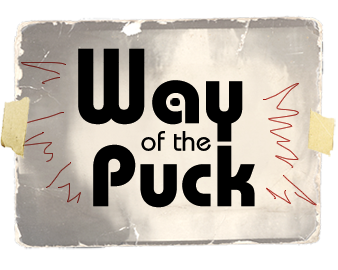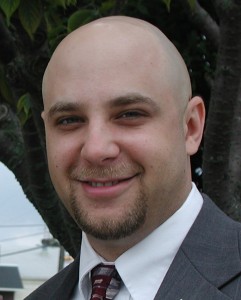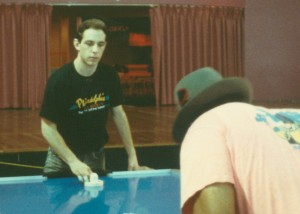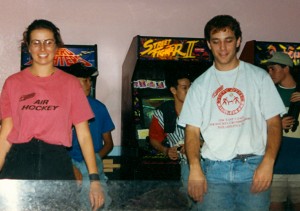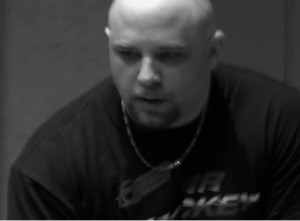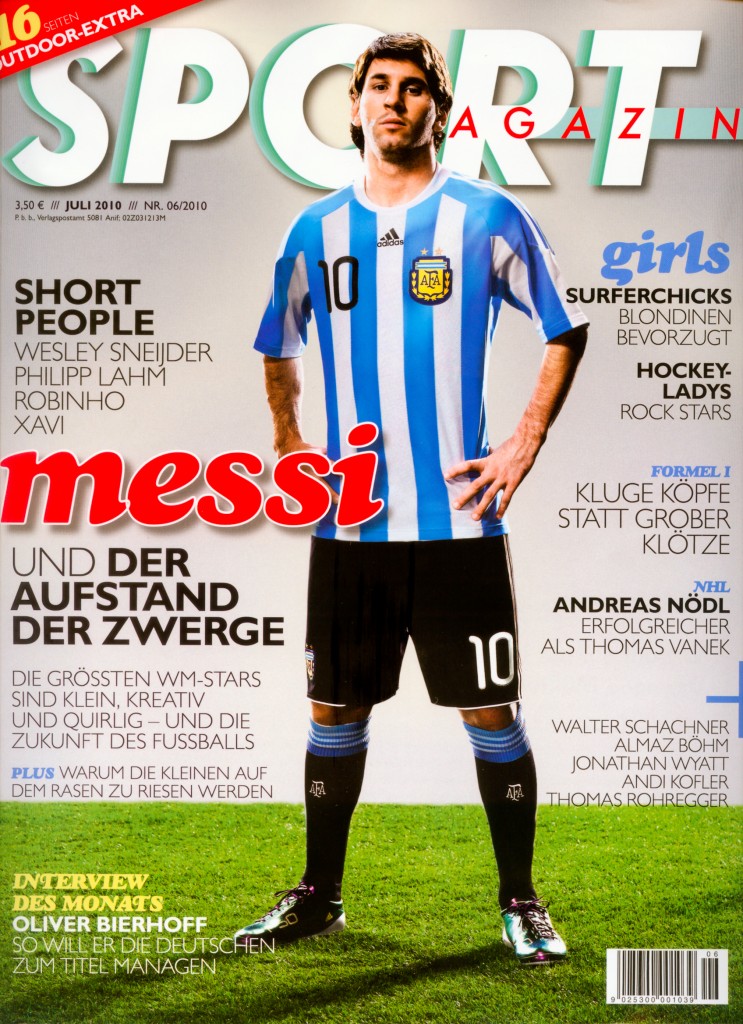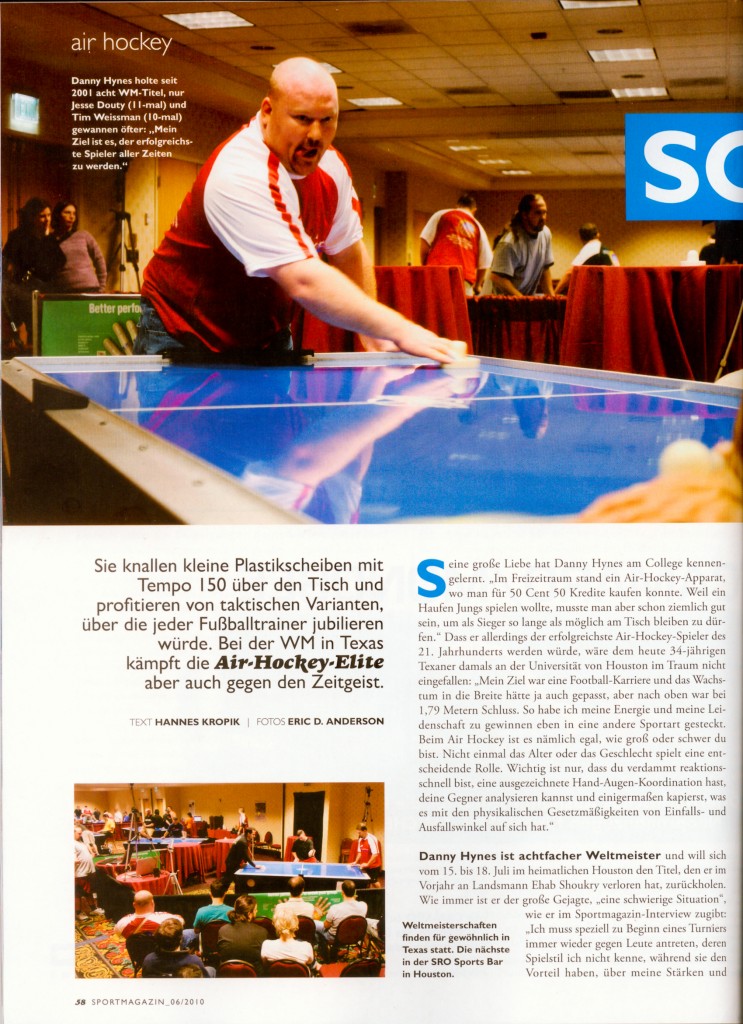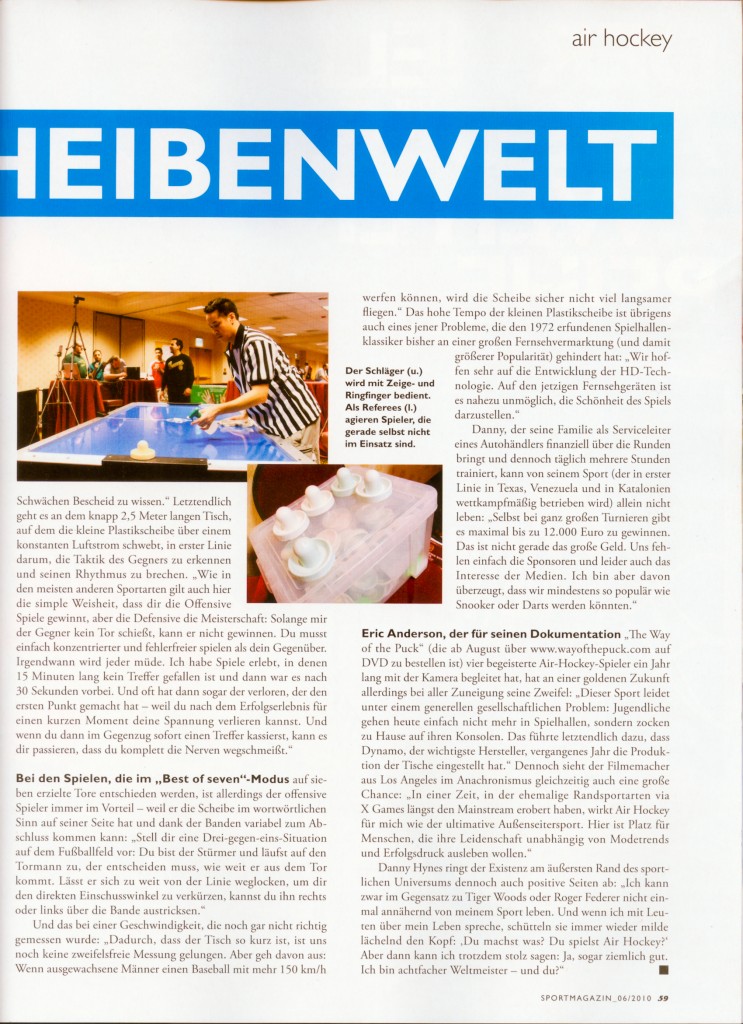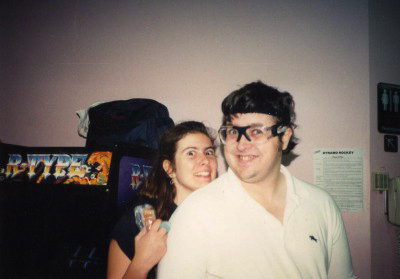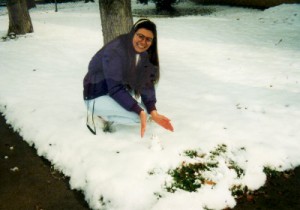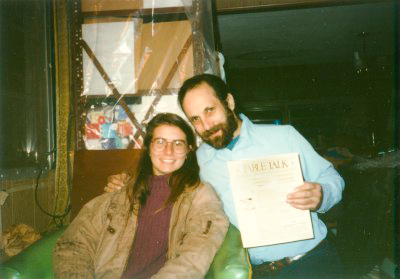WOTP Now Available As a Digital Download on Amazon
Way of the Puck is now available as a digital download at Amazon for only $7.99. If you’re just interested in watching the film and not so interested in any of the bonus features or packaging, this could be for you! See the link for further details…
http://www.amazon.com/Way-Puck-Mark-Guru-Robbins/dp/B007QP3EZK
Quality Review at Curled Up With A Good DVD!
By Eric Renshaw
If you’re anything like me, you play air hockey poorly, fumbling the puck and shooting it into my own goal. The players featured in Way of the Puck have the skills to put me to shame (better than even I can myself), and they all share a rabid love of the game.
Many of them have been playing since air hockey hit the scene back in the ’70s. They shun holding the rounded handle that juts from the top of a traditional air hockey mallet, opting instead for a three-fingered grip on the mallet that gives them more control.
Director Eric D. Anderson, himself a competitor, traces the history of the game and details the lives of several players who compete in national championships. Mark Robbins (“The Guru”) is an encyclopedia of knowledge, and his garage holds a fortune in equipment and treasures (including a virgin table, mint in box). Tim Weissman (“The Ex-Champ”) is credited with creating the circle drift and with bringing thought and strategy to the game. Andy Yevish (“The Promoter”) is an artist whose wife is not exactly thrilled with all the time Andy spends promoting, arranging and playing the sport.
Way of the Puck calls to mind King of Kong: A Fistful of Quarters in how the players’ dedication is portrayed and how the tournaments are covered. Both films brought a true excitement to subjects that don’t set my soul on fire by their nature. It also reminds me of the clever documentary Welcome to Macintosh, mostly in the time spent on Mark Robbins – the trip through the stuff in his barn shares similarities with scenes in Welcome to Macintosh.
To take a subject like air hockey that has a, shall we say, less than massive following, to make it interesting and compelling enough to inspire its viewer to want to seek out that mostly ignored air hockey table at the local arcade and try out that three-finger grip is quite an accomplishment. I say well done.
Lost Interview With Venezuelan Sensation Pedro Otero
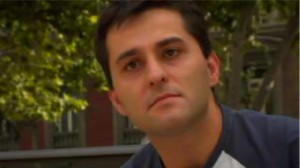
Pedro Otero
If Jose Mora is lithe, lanky, elegant Seattle Mariner Ichiro Suzuki, then Pedro Otero is power hitter Hideki Matsui. All honed their skills playing professionally abroad, then emerged as dominant “rookies” on the international scene. Unbelievably, Otero competed in only four world championships, finishing second in 1998, 1999, and 2000, and finishing fifth in 2001. It is a masterfully short career, and Pedro has probably the highest average finish-per-event in air hockey history. Known for his rock-solid defense, and uniquely powerful (and difficult to defend) right-wall-over, Pedro lived in the competitive shadow of his friend and fellow countryman Jose Mora, who edged him out in three successive tournaments.
We traveled to Madrid to speak with Pedro back in the summer of 2004. The footage was never used in the film, but we wanted to publish a short excerpt of the interview and wish him well.
WOTP: Can you tell me how you got started?
PEDRO: I began playing in the city of Caracas in Venezuela in 1994. I was seventeen years old, and I began playing with some friends. We played our games at Arcade City, which is where we played for many years. Over time, more people joined us. My normal practice partner was Jose Mora. We spent a lot of time practicing together. I can say that our levels were equal because of our consistent practice. We practiced very often, practically every day, and that helped us reach a level that allowed us to travel in 1998.
WOTP: How did that all come about?
PEDRO: In 1998 Jose and I decided to travel to the international tournament in Santa Cruz, California. Tim Weissman helped us in our adventure –- to find some manner to travel to the United States. He made a collection of money amongst the players over there. And he facilitated ticketing information and things like that. I can say that if it were not for him, I believe that we would never have been able to go.
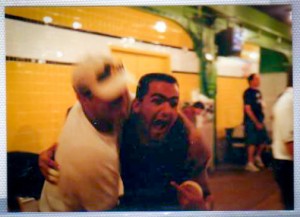
The exuberant Jose Mora
But we still had to embark on a 79-hour one-way bus trip once we arrived in the United States, without knowing, really, what expectations we had for winning, nor having been able to compare or contrast or playing level with the players there. I realize it was a stupid thing to do, an odyssey based more than anything on youth. But in reality, I’m sure neither Jose nor I regret it. And the fruits of this [Jose and Pedro finished first and second place] demonstrate that it was worth the effort.
WOTP: Were there style differences that allowed you succeed against the US players?
PEDRO: I believe that our style is different because in Venezuela we had many more players to compete against – the player base in Caracas was larger than any other city in America, except maybe Houston. There was more of a variety of rivals, which is why I think our style had to be much more complete. We could not just mold ourselves to the characteristics of one player. We had to have a game that was more compact and as complete as possible.
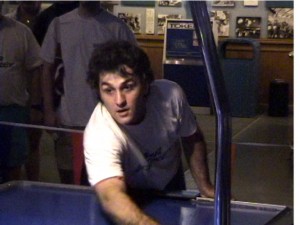
Pedro hits his unique RWO (Right Wall Over)
When I beat Tim Weissman in the semi-finals, I can say that is the biggest moment that I have lived inside of air hockey. And one of the best moments of my life, without a doubt. I can still remember that moment, everything that surrounded it, how I got to that moment. I can say that although I was beginning my career in air hockey, it was the culminating moment as well.
WOTP: How did you end up in Spain?
PEDRO: In the year 2001 I was trying to go live in the United States, because the situation in Venezuela wasn’t adequate. Andy Yevish helped me a lot. He was very helpful. Lamentably, in the end, things could not be. But I am still very grateful to him.
My family members and I decided to come to Madrid, but there is really only air hockey in one city in Spain, which is Barcelona. Generally, this isn’t very good for me because it is about 600 kilometers away. In all sincerity, it was very hard to stop practicing air hockey so much after eight years of uninterrupted play, but there came a moment when I had to recognize that life has other priorities.
WOTP: Do you miss it?
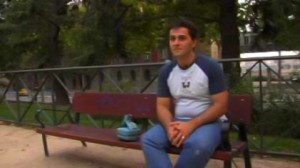
Pedro’s new home: Madrid.
PEDRO: Truthfully, air hockey has given me many good moments, some of the best moments in my life. It has helped me feel that I can attain what I set out to do. In some ways I feel empty having left air hockey. But if were up to me –- under ideal circumstances –- I would have continued playing for the rest of my life.
Air hockey is a sport that teaches you the skills to better yourself in life. And for me, it has helped me realize myself as a person. Others I have played with have made the same comment –- that it’s extremely fun and competitive, and you enrich yourself as a person while playing it.
But one of the best things about air hockey is that you become like a small family, and always maintain contact. We always know about each other. And wherever you go, other air hockey players will know you are there and seek you out. It is something like a chemical between us, between all of us who have played. And that is something special.
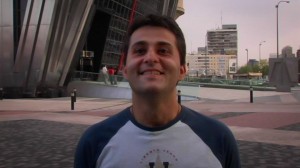
Vote for Pedro!
Thanks, Pedro!
Great Review in Suite 101
By Barbara DeGrande
Director Eric D. Anderson has documented a fast-paced, quirky sport; the unique individuals who are passionate about the sport; and its questionable future.
Eric D. Anderson, himself a one-time nationally rated air hockey player, puts his experience behind the camera to use in documenting the intense, little-lauded sport of air hockey in this, his first feature film. Like the sport itself, Anderson’s film is intense and offbeat, using antique stills and videos interspersed with stills and videos of the players in their younger days, some history of the sport including its NASA origins, and scenes of video arcades filled with aging mid-lifers pursuing their youthful dreams of success in a sport of their passion.
As arcades themselves begin disappearing, losing out to the burgeoning of computer and video games, these anachronistic advocates of a dying sport look at what is possible for the future of air hockey. Anderson’s film is always respectful of the sincerity of the air hockey advocates and the sport itself, yet spares none of the troubling aspects of the sport and its future.
Those who are invested in air hockey and its tournaments are a unique group of people, many with nicknames like The Wolf, The Juggernaut, and Egyptian Magician. There appears to be a small group of dedicated international players that love something of the incredibly quick reaction time of the sport, estimated at 1/600th of a second. Many have to buck negativity from spouses; others have full support and encouragement. One man reflects of the totality of his life against the fleeting victories of the sport he loves, trying to convince himself he has the better of the deal with his family behind him. Is air hockey a child’s game or a world-class sport?
Who is to decide? There are men in the inner circle of air hockey advocates that have spent their life promoting the sport, including guru Mark Robbins, who holds much of the history of the sport. When one young enthusiast is tossed aside by his girlfriend, he is told, “Air hockey still loves you.” For some, the diversion is a welcome relief from the difficulties of everyday life. There is no misery on the table: “Praise the table!” is the refrain. The profiles of the personalities involved in the sport is part of the delicious bits of this film that need to be savored.
One air hockey tournament offers a $14,000 prize, an all-time high for the sport. As men are seen taping their fingers for the next tournament, they reflect on their attitude towards the game. Two Venezuelans attend a tournament and are later discovered to have been using an upside down kitchen table to learn to play the game. Suddenly, the minority that is the air hockey corps reels from learning they are actually the privileged group in comparison with these enthusiasts.
The film flies us from their NASA origins to gaming in Japan to an air hockey expo on The Tennis Channel. One enthusiast discusses the need for a professional promoter to save the game; another is seen traveling from one tournament to another, investing everything in keeping the dream alive — even leasing the molds from a former distributor that has long since quit making pucks for the game. Perhaps Anderson’s film will do what others have failed to do and help regenerate interest and profitabililty in this short-lived sport. In any case, it is a fast-paced look at a piece of the culture of Americana grown global. Worth a look.
Nice Review in Just Press Play
By Tom Hoeler
If you grew up in America between 1970 and probably the turn of the century, chances are you’ve played air hockey at least once. A staple at arcades around the country, air hockey was also once a very popular addition for any family basement or entertainment room. That familiarity is the basis for Way of the Puck a documentary by director Eric D. Anderson that chronicles the growth, decline and near decimation of the sport, and the story behind those that play it competitively. Yes, there is competitive air hockey.
Watching the film certainly evokes memories of The King of Kong, another documentary that focused on the zeal and passion of a group of competitors devoted to another so-called fringe hobby, video games. While there are some similarities, The Way of the Puck seems far more tragic. For the players in The King of Kong video games are merely part of who they are. They have families, jobs and are relatively successful outside of the arcade. Additionally, the video game industry is booming, even if arcades themselves are dying out; so the pursuit of gaming records doesn’t seem as fleeting.
In contrast, for the players in The Way of the Puck this is their life…. (click link for rest of article)
Read more: http://www.justpressplay.net/reviews/7121-the-way-of-the-puck.html
Way of the Puck DVD Release Party
HOLLYWOOD, California: Way of the Puck, the just-released documentary about professional air hockey, was feted Thursday night at Barney’s Beanery’s landmark West Hollywood location. Air Hockey World Champion Davis Lee Huynh and second-ranked California player Joe Cain journeyed from the Bay Area to celebrate and to mentor guests about the finer points of air hockey tactics and technique.
Michael Rosen, Commissioner of Major League Air Hockey, traveled from New York City to meet the extended creative team behind Way of the Puck and to encourage more competitive air hockey play in the Los Angeles region. Rosen is one of four central characters followed around by director Eric D. Anderson in the feature-length documentary. “It was a perfect way to kick off our DVD release,” said Anderson. “We had guests fly in from all over the country, including a large contingent from Seattle. Then again, I shouldn’t be surprised, since fans of air hockey tend to be passionate people!”
Anderson and guests tried their luck against the three professional players on a new Dynamo Fire Storm air hockey table, purchased by Barney’s Beanery for the event. “It was important to me that we choose a venue where people could play a little… and hopefully re-experience the singular, inexplicable pleasure of hitting a lexan puck across a floaty blue surface.” Pucks and mallets were provided for the occasion by Mark Robbins, air hockey guru and CEO of Shelti, a Michigan-based table games manufacturer. Way of the Puck is the only feature film that digs into the curious subculture of competitive air hockey. It is currently available for sale at the film’s website: https://wayofthepuck.com
Way of the Puck DVD Design
Check out the new DVD casewrap for Way of the Puck! Many thanks to designer Eric Sommerfeld for his great work.
Please note that this collector’s edition DVD will contain:
- The full 81-minute Way of the Puck movie with Stereo 2.0 and 5.1 surround mixes
- Feature-length audio commentary with director Eric Anderson and air hockey guru Mark Robbins
- Eleven deleted scenes
- High resolution trailer
- Enhanced anamorphic presentation for widescreen televisions
- Our “Repeat after me: I can become the best air hockey player in the world, I just have to want it badly enough” postcard
- Scene selections
- Mr. Sommerfeld’s excellent DVD face and casewrap design.
Also note that the downloadable and streamable versions of WOTP available in the coming months will not contain these extras!
Philosopher Lou Marinoff Weighs In On the Importance of Air Hockey in Our Society
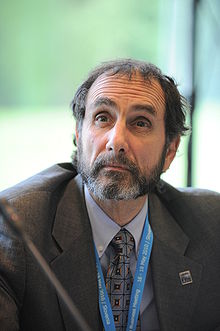
Lou Marinoff
Like many fringe sports, air hockey is an activity that inspires profound existential questions in those who love it. Nostalgic documentaries like Ken Burns’ latest effort seem like easy, non-threatening missions — we love baseball, it is our national pastime, and we also love our love of baseball, which usually harkens back to an earlier time in life, when we were more innocent, when players were drug-free (well, just a different kind of drug — speed, perhaps), when these athletes were real role models, heroes even.
What’s harder is placing air hockey (or darts, or shuffleboard, or baseball card collecting) in a similar context. There is no assumed national love for these activities. The same passion that is celebrated in Ken Burns’ beloved Baseball or Tenth Inning is called into question when looking at air hockey. But should we not celebrate passion for passions sake? How obviously worthy is hitting a ball with a stick and running around to different safe zones like a grown-up game of tag?
Three-time table hockey champion Lou Marinoff has given much thought to these very questions. As a philosopher and author, it’s difficult for him not to ruminate at length on society’s indifference to these outsider sports — why it is that the very that you’ve been chosen to do — that you excel at — is kicked to the curb, or even worse, ignored. And what to do about it.
We spoke at length to Mr. Marinoff about these and many other issues.
WOTP: What are the differences between air hockey and table hockey?
LOU: There are many differences between table hockey and air hockey, although they are related to the same pure form, as Plato would have it: the form of hockey. The whole idea is that you have a game with boundaries and you try to put a puck into a net. How many players you have, what kind of puck you have exactly, whether you hit the puck with a stick or with some kind of a knob depends naturally on the kind of game you’re playing, but it’s all related to hockey.
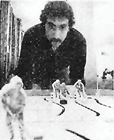
Lou on the prowl
The main thing is: With table hockey you have a team of players, which makes it look like ice hockey in miniature. You generally have a goalie and defensemen and wings, and you have the capacity to move, pass the puck back and forth. And generally one of these players will do the scoring.
In air hockey you have to do it all. You have one player who is basically controlling offense and defense together, very quickly. The transitions are very fast. And so the game is much faster. There are fewer possibilities in terms of who you are going to pass the puck to. There’s no one to pass the puck to, but you have to make a play off the boards or make a great defensive play, so there are similarities and differences, but it’s based on the same concept.
WOTP: Why does this appeal to you?
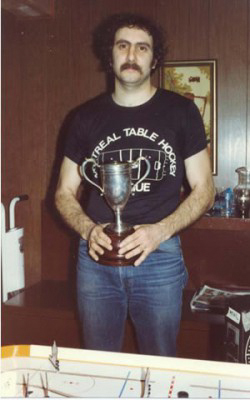
To the exhausted victor go the spoils!
LOU: There are a lot of reasons why this is interesting to me as a philosopher and as an educator, and the first one has nothing to do with hockey. It has to do with a bigger facet of the human being, and that is games and play. We are not the only animal that plays. The other primates play a bit—otters play, dogs and cats play occasionally—but human beings have taken and evolved the concept of games and play to a really high level and a lot of our lives are consumed with playing.
Playing is very important to children for their development and play is important for adults, one way or another, whether it’s games or sports. Most of us end up playing something on a lifelong basis. Music is play. That verb “play” applies to a lot of facets of human existence, so it’s obviously something important for our species. And then the question is, where do you grow up, what part of the world are you from geopolitically, so what are you going to be exposed to when you’re young, in terms of games? Hockey? This is a game more for the northern latitudes and kids grow up with great passion for it, whether it’s table hockey, ice hockey, field hockey, air hockey, it’s all part of the same great game.
WOTP: But is it always play? Or is it something else?
LOU: Philosophically this is interesting: What is a game doing? When we play a game, basically we engage simultaneously between competition and cooperation. We need to compete with each other because often competition brings out the best in a human being. You discover your excellence sometimes only when you’re under pressure, when you really have to come up with a great play, you know, come up with the goods! That’s what spectators come to games for, right? They want to see the athletes performing at a high level. So competition drives us achieve our best in terms of performance. But we also have to cooperate. Table hockey, air hockey, ice hockey—these games teach sportsmanship because you need the other person to compete. You go out there by yourself and you don’t have a game. You can go out there and skate around or just move the puck around, but you actually need another person to compete!
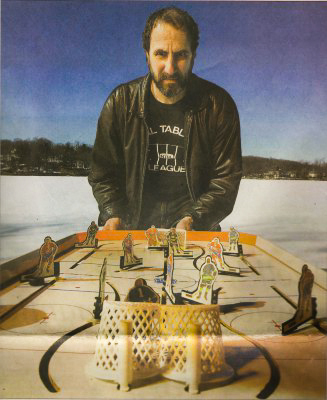
Toy? Game? Sport? Or something larger?
WOTP: I guess what I’m getting at is, well, is there some kind of line between game and sport and where do you draw that line?
LOU: Really it has a lot to do with the medium in which this game is being enjoyed and witnessed and are being transported. If you ask the manufacturers what they are selling, very often they don’t even think it’s a game… they think it’s a toy. Table hockey had this problem for a long time. The people who made it were toy manufacturers, and only understood toys.
Then when they say, “Hey wait a minute, grown men are taking this seriously, okay it must be a game. It’s got this competitive edge; there’s a lot of sophistication in it.” As in air hockey, I’m sure, there are very sophisticated plays that can be made and so forth.
So it looks like a game. But what happens to the top players when people get really good at this game? They find other people who are also really good and have achieved a great level of play, and then they want to compete seriously. At that point it’s sport. At that point it starts to taste like a sport. It’s not just a game anymore.
But it is a little different with air hockey and table hockey. Why don’t we look at pro football players, hockey, soccer, and say: “You’re playing a kid’s game, what’s wrong with you?” Of course they’re playing a kids game! The only way you could ever get to be a professional is to start early enough in life and get the muscular memory going—get the techniques into your immature neurological systems—so as you develop into a human being you have those skills!
WOTP: Do you ultimately think there is something rebellious about mastering an antiquated table game like this?
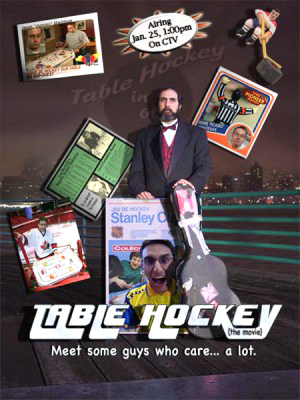
Lou’s other worthy film: Table Hockey (the movie)!
LOU: Well, the car was invented a while ago and it’s still with us. If you look at tennis racquets and baseball bats and footballs and soccer balls… there are a lot of things that were invented decades ago—maybe centuries ago—that are still with us! So I wouldn’t be too prepared to dismiss something just on the basis of its antiquity!
Sports evolve, however, and I think the point that you make that is really interesting, is to look at the contrast between computer games and virtual games and real games. I’m claiming that one of the strengths of air hockey and table hockey is that they are real and not virtual. I think people want more reality than what they are getting.
Ultimately, you can look at a game like Nintendo, which captured worldwide a generation of children. It was a universal language, actually, for children. They could all get together and play Nintendo. Whether it’s Sega or Gamecube or whatever, the fact of the matter is that these are virtual and not real. The action is taking place on a computer screen, not in a three-dimensional space-time setting and the skill set you need—however adroit these people are at manipulating the control pads—it’s not the same kind of hand/eye coordination you need in reality!
So table hockey and air hockey both belong to a class of games that are played in space-time, 3d, with a real opponent standing on the other end of the table. And there is something there that is irreplaceable.
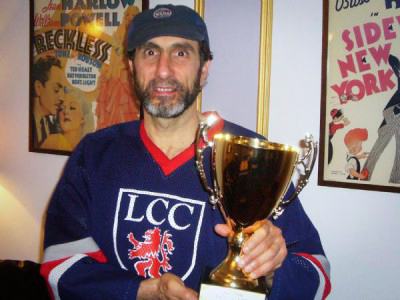
The Comeback Kid of table hockey!
We are human beings. As such we need to function in real terms as well as in virtual ones. And if you start asking people, “Which is better: e-mail or real mail?” Well, they’ll tell you e-mail’s faster, it’s cheaper, it’s instantaneous, we can communicate around the world and all that, but you know what, people should never forget about the satisfaction of writing a letter to somebody… and getting a letter from somebody. That’s something that you really keep and can cherish and reread and has a certain kind of value. I know that the visual tradition has unfortunately supplanted the written one, but people still need to appreciate the virtues of reality and if they can’t do it with literature and letters and stuff, because the e-thing is really what’s happening, they have to do it with sport!
And there is a certain satisfaction to scoring a goal in the real world that you will never be able to replicate in virtual terms!
—
Thanks, Lou!
Lou Marinoff is the author of many bestselling books, including The Middle Way, Therapy For the Sane, and Plato Not Prozac. His many areas of professional and personal interest are showcased at his website: http://www.loumarinoff.com/.
My Cousin’s Kid Interviews the Beast From the East
Two-time runner-up Andy Yevish was first discovered on the boardwalk of the Jersey shore, where as a lanky teen he beat former World Champion Robert Hernandez in an air hockey exhibition. Andy already had a reputation as an aggressive offensive player, and this shocking unofficial victory brought him into the fold of competitive play, where he immediately began finishing in the top five, including a 2nd place finish to air hockey wunderkind Tim Weissman in 1993.
Andy organized a couple of east coast tournaments in the early 90s, and took over the promotion of the World Championships in Las Vegas in the early 00s. As a player and as a promoter, he has been no stranger to controversy… but it is difficult to deny his formidable offensive attack, which remains one of the best in the game. Even so, Andy has been unable to translate his brilliant and powerful offense into a World Championship. At the age of 42 he is much older than the oldest air hockey champion in history and the question lingers: “Will he ever win one?”
Incredibly, my cousin’s 11-year-son, Henry, is still maintaining his high level of interest in the sport of air hockey. He asked if he could do one final interview, so I let him fire away on the self-proclaimed Beast From the East, Andy Yevish.
HENRY: The movie says that you have one of the best offenses of all time. Is that true? But Eric says that you play “all offense and no defense.”
ANDY: Hi Henry, Yes… I would say that the consensus is that I have one of the best offenses ever in air hockey. I have more shots, more variety, and more styles of play than most players. I can play both fast and slow, and can be deliberate, or fancy… But Eric is wrong if he says I play all offense and no defense. I think most players who play me will tell you I also have one of the best defenses. I vary my defense to the player’s strengths. I change my weaknesses. However, what Eric may be referring to is that one of the ways I play defense is what I call a “scoring defense” where the defense becomes offensive. I use my opponent’s taking themselves out of position by taking their own shot as an opportunity to hit a quick transition shot. It is a gambling strategy, as it is high risk, but high reward. I do not play that strategy all the time though.
HENRY: What is your best craziest shot that other people don’t do? I want to crush my friends at air hockey!
ANDY: Well interestingly, the crazy shots usually aren’t the best shots. A well-aimed, well set-up shot is the best way to beat all your friends. Stop the puck every time you get possession, then set up your own well-aimed shot. Taking your time, and hitting from your power area will help you beat all your friends.
HENRY: In the future is air hockey going to die?
ANDY: Well, I don’t know the future, but I hope not. There are plenty of people working hard to keep it alive. My best guess it that it should a least be able to maintain itself, but in order to get big, some major changes will need to be made. I think a television show designed to showcase ai hockey competition in a 30-minute format would be a good vehicle to get it noticed. From there, air hockey related equipment and clothing could be the thing that gives air-hockey eternal life.
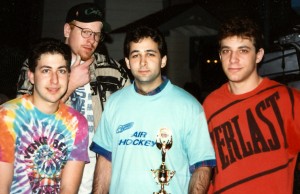
Andy and the innocent East Coast Crew, before Andy lost his shirt contract with Everlast. Product placement wasn’t so subtle back then, I see.
HENRY: The movie says you were a boxer. Is it fun to punch people in the face but not get in trouble?
ANDY: Heh-heh… One might think of it as being fun… and boxing to me was fun, but I don’t think of it as hitting people in the face. I think of it as an art form. Much like I think of air-hockey as an art form. When you are boxing, you often forget it’s a fight and think of it as a sport… Sometimes, you have to suck it up and dig down to primal instincts… usually late in a fight, or when you’re tired or hurt, and that’s when you remember you’re in a fight, and you realize you’re hitting each other. At that point, no… it’s not fun.
HENRY: Do you train like Rocky the boxer before a big tournament? What are the exercises to prepare the air hockey muscles?
ANDY: It used to be well known that I used to physically train before tournaments, and not drink, smoke, and abstained from women. That was before I got married, and older and I was only in good shape if you consider “round” a good shape. Recently I have gotten in better shape than I have been in 10 years (not how I look in the movie). I never trained for air hockey in particular, but I had back problems, so I trained in order to have the endurance to play my best without pain. My workout regimen now (which I do all year) is I bike 10 miles a day, do a 20 minute ab routine (which keeps the weight off and strengthens the muscles to keep my back from hurting), I do about 120 pushups a day (4 sets averaging 30 each set with vared arm placement… but more reps in the earlier sets). Then I hit weights 3 times a week (about every 2-3 days.. I do 4 sets of 15 reps with 25lb dumbbells of each of the following exercises- bicep curl, tricep press, military press, and chest flys. When I do get a chance to get to the gym, I do some other exercises, like bench pressing and butterflies but with my lifestyle it’s hard for me to get there. I will soon be adding squats to the routine on off-days.
HENRY: Do you have a secret grip?
ANDY: I don’t have any grip that is a secret. I actually vary my grips on the mallet, depending on the action I want to get on the puck. As a general rule, a tighter grip will get you more arm power, and a quicker release. A looser grip will let the mallet do more of the work (especially when you hit it with follow-through) and get more action (like slice) on the puck.
HENRY: My dad wants me to ask is the Jersey shore really like on that TV show?
ANDY: Unfortunately… yes.
—
Thanks, Andy!
Andy Yevish is a portrait artist and entrepreneur who splits his time between Wildwood, New Jersey — where he owns two stores on the boardwalk (Fame and Superstars) — and Sherman, Connecticut, where he enjoys a more rustic existence with his air hockey averse wife, Anna.
Danny Hynes ist achtfacher Weltmeister!
I’m pretty sure this means “Danny Hynes is an eight-time world champion,” if my remedial high school German serves correctly. The Germans do compound nouns as well as the Japanese do compound verbs — that is to say, brilliantly — and WELTMEISTER sounds pretty freakin’ great for a title if you ask me.
Yes, fearsome 8-time champ Danny Hynes was featured recently in an Austrian sports glossy called, well, SPORT. Probably one of the most brilliant defenders of the modern era, Hynes also has a varied attack that combines brutal straights and unders with delicate off-speeds.
He also has superb Hand-augen-Koordination!!!!
Babelfish does a decent job decoding this article; any German-speakers out there to help with the subtle bits?
Click on the images below for a full-sized scan of each page!
Match.com Circa 1980
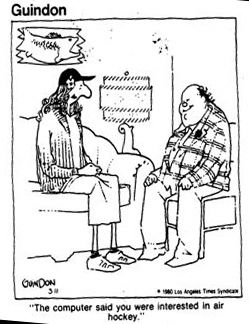
.
Thanks for this gem, Mark!
My Most Memorable Air Hockey Moment: Kara (Klyn) Adema
Kara Adema (formerly Klyn) was the most dominant air hockey women’s champion in the 1990s. But she wears that crown with kind of a dubious pride, and for many years campaigned against the need for gender specific rankings. For her there was always only one true world ranking: the one that was obtained against all of the testosterone in the room. Although she has been retired from air hockey for the past decade, she was a permanent fixture during the middle third of its history.
We feel very lucky to have tracked down the legendary Kara Klyn for this article! We asked her to talk about her most memorable air hockey moment, and this is what she said:
All air hockey players remember the table that got them hooked. I was 19 and it was 1989 in a shaggy little arcade in Fremont, California called Galaxy. They had ten shiny-new Tornado foosball tables and one Dynamo brown top. I could never beat any of the guys in foosball. But on the air hockey table—that was a different story.
Somehow, a flyer for an air hockey tournament in Mountain View—about 20 miles away—made it to Galaxy. They guy behind the counter there was excited to show it to me. A few weeks later I found myself at the California State Championships with some of the best players in the world. I had no idea air hockey could be that competitive, or that amazing. That first moment seeing professional play I was so intimidated I wanted to fade into the background and just be one of the girls that just looks on. But the look on my face gave me away. I wanted to play like them. And they wanted me to learn. Even though I was thoroughly defeated in that tournament, I won friends there that I would play against, and travel, promote, and experience random adventures in life with for the next several years.
By the time the early 90s came around I was working with Mark Robbins and Tim Weissman and was fully entrenched in promoting the sport in California, and occasionally around the country. I was learning the art of organizing major tournaments and building up prizes. I loved traveling and meeting new players. I had won a couple of women’s championships at that point and while having that title was very cool, my overall ranking was for me, personally, disappointing. Even if it was considered “good” for a female player. But it so happened that my best air hockey moment happened that same year in Littleton at a Colorado state tournament.
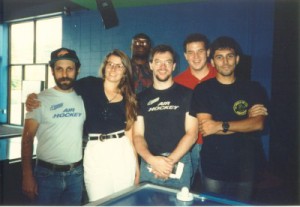
Mark Robbins, Kara, Tim Weissman, Don James, and the late Owen Giraldo. Anybody know who the guy in back is?
I was a hippy at heart then and I felt like I just fit right in with all the friendly people and the beautiful country. Being short on cash in those days I stayed with local players. I thought it was cool that the Colorado players that had been around the air hockey table a few times had a Brunswick table in their living room. Mark showed me “The Barn” filled with Brunswick tables. And by helping Mark with a few odd jobs around his place (and there are plenty of opportunities there;), one might luck out and score a Brunswick mallet, a devastating Berger puck, or some other interesting piece of air hockey history he has buried there.
But my best moment happened in a little sunken arcade within a giant indoor entertainment center. Spirits among the players was high that weekend. There was fresh snow (which was a treat for the Californians and Texans), great friends, a new laser tag gallery which we had passes to, and some truly great angles to video tape play from above the arcade pit.
While all tournaments are fun and intensely competitive, this one had a little extra undertone of fun infused in it. I went in the losers bracket my second or third match. Then something happened. I don’t know if I just stopped worrying about when I would lose and let my instincts take over, or if I found a new confidence from within. But I just kept on winning my matches. I rose above all but seven other players that weekend in the main bracket. I remember watching a video tape of that final match thinking…”Is that me playing?”
It’s been almost 20 years, since then and I think it was the highest finish ever by a woman. I didn’t even realize that at the moment. Does it still stand? I don’t know. I have won seven women’s titles against some very tough women (Andy Yevish and some others may say six titles, but that’s another story itself). But placing eighth in the main bracket was by far, my best air hockey moment.
Editor’s note: In a future installment Kara will break down her personal vendetta against the notion of holding women’s tournaments in air hockey. Looking forward to it, Kara!
Kara met her future husband Mike in 1991 and became one of the first functioning air hockey couples. They were married in 1999 and now have a beautiful daughter. Although Kara’s been out of air hockey for a while—in order to concentrate on school, career, and family—she and Mike still play each other on an old Brunswick, next to that Mustang (the other classic) in the garage.
Her portfolio and design work can be seen at: http://www.karaadema.com/
